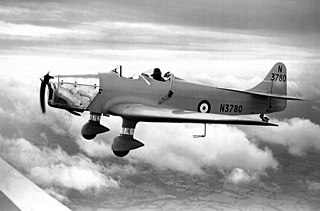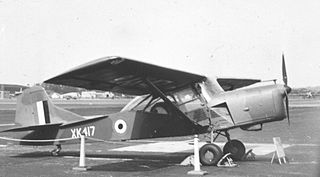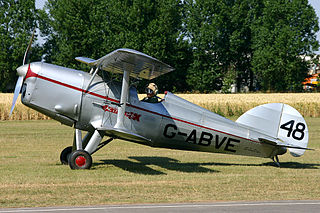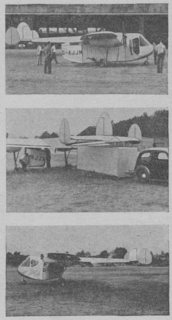The Miles M.18 was a single-engine twin-seat low-winged light British civil utility aircraft of the 1930s.
The Miles M.18 was a single-engine twin-seat low-winged light British civil utility aircraft of the 1930s.
The Miles M.18 was a series of three slightly different prototype aircraft.
The M.18 Mk.1 was a two-seat tandem training aircraft, powered by a 130 h.p. de Havilland Gipsy Major which was first flown on 4 December 1938 from Woodley Aerodrome near Reading by F.G. Miles. The sole example G-AFRO was converted to a single seater in 1941, with a fixed tricycle undercarriage and with the fin and rudder moved forward by 22 in. It later reverted to a tail wheel undercarriage layout and flew during 1946-1947 with its span reduced from 31 ft 0 in to 22 ft 0 in and a 110 h.p. Jameson FF engine was installed. It was scrapped in December 1947. [1]

The M.18 Mk.2 had the fin and rudder moved forward by 22 in and was fitted with a 150 h.p. Blackburn Cirrus Major III. The sole example, serial HM545, [2] first flew at Woodley in November 1939. It was evaluated by the Air Ministry as a possible replacement for the Miles Magister. [3] According to test pilots, it handled better than the Magister, was impossible to spin and flew well at night. [3] However the Mk.2 was regarded as lacking robustness. [3] The Mk.2 was used through the Second World War as a communications aircraft by Miles Aircraft. It was civilianised as G-AHKY and won the Goodyear Trophy air race in 1956 at 130 mph and the Kings Cup Air Race in 1961 at 142 mph. [4] After ownership by several private pilots, it was retired in 1989 and from 1996 to date, the aircraft has been on display at the National Museum of Flight in Scotland.
The M.18 Mk.3 was fitted with enclosed tandem cockpits and powered by one 150 h.p. Blackburn Cirrus III. The sole aircraft, U-0236, first flew at Woodley in October 1942. It was used by Miles for wartime communications as JN703, before civil sale as G-AHOA in 1946. It had two private owners before crashing at Littondale, Yorkshire on 25 May 1950. [4]


Data from Jackson, 1974
General characteristics
Performance

The Miles M.14 Magister is a two-seat monoplane basic trainer aircraft designed and built by the British aircraft manufacturer Miles Aircraft It was affectionately known as the Maggie. It was the only low-wing cantilever monoplane to ever be authorised to perform aerobatics.

The Percival Gull was a British single-engined monoplane, first flown in 1932. It was successful as a fast company transport, racing aircraft and long-range record breaker. It was developed into the Vega Gull and the Proctor.

The VEF I-12 was a tandem, two seat Latvian trainer aircraft designed by Kārlis Irbītis and produced by VEF in Riga.

The Miles M.57 Aerovan was a British twin-engined short-range low-cost transport aircraft designed and produced by Miles Aircraft. It was primarily used for freight and passenger services.

The Miles M.38 Messenger is a British four-seat liaison and private owner aircraft built by Miles Aircraft.

The General Aircraft GAL.45 Owlet was a 1940s British single-engined trainer aircraft built by General Aircraft Limited at London Air Park, Hanworth.

The Auster AOP.9 was a British military air observation aircraft produced by Auster Aircraft Limited to replace the Auster AOP.6.

The Miles M.28 Mercury was a British aircraft designed to meet the need for a training and communications plane during the Second World War. It was a single-engined monoplane of wooden construction with a twin tail and a tailwheel undercarriage with retractable main units.

The Chrislea Super Ace is a 1940s British four-seat light aircraft built by Chrislea Aircraft Limited.
The Arpin A-1 was a two-seat low-wing monoplane which was powered by a single radial engine in pusher configuration, mounted behind the cabin between twin booms that carried the tail. An unconventional fixed tricycle undercarriage was fitted. Only one was built.

The Arrow Active is a British aerobatic aircraft built in the 1930s.

The Blackburn Bluebird IV was a single-engine biplane light trainer/tourer biplane with side-by-side seating designed by Blackburn Aircraft. It was an all-metal development of the wooden Blackburn Bluebird I, II and III aircraft.

The Blackburn B-2 was a British biplane side-by-side trainer aircraft of the 1930s. Designed and built by Blackburn Aircraft, 42 were built.

The Miles M.2 Hawk was a twin-seat light monoplane designed and produced by the British aircraft manufacturer Miles Aircraft Limited during the 1930s. It is the first of the company's aircraft to attain quantity production.

The Miles Hawk Major was a 1930s British two-seat light monoplane developed by Miles Aircraft from the Miles Hawk.

The Miles M.4A Merlin was a 1930s British five-seat cabin monoplane built by Miles Aircraft Limited.

The Miles M.65 Gemini was a British twin-engined four-seat touring aircraft designed and built by Miles Aircraft at Woodley Aerodrome. It was the last Miles aircraft to be produced in quantity.

The Miles M.9 Kestrel was a 1930s British single-engined tandem seat monoplane, intended as an advanced trainer. Only one Kestrel was built but it was developed into the Miles Master for the RAF and produced in large numbers at the start of the Second World War.

The Miles M.68 was a 1947 attempt to produce a containerised freighter aircraft by the modification of the Miles Aerovan. The container or air-trailer was part of the fuselage but could be dismounted and towed on the road.
The Hillson Helvellyn was a 1940s British two-seat training monoplane designed by Norman Sykes and built by F Hills & Sons of Trafford Park.
| Wikimedia Commons has media related to Miles M.18 . |